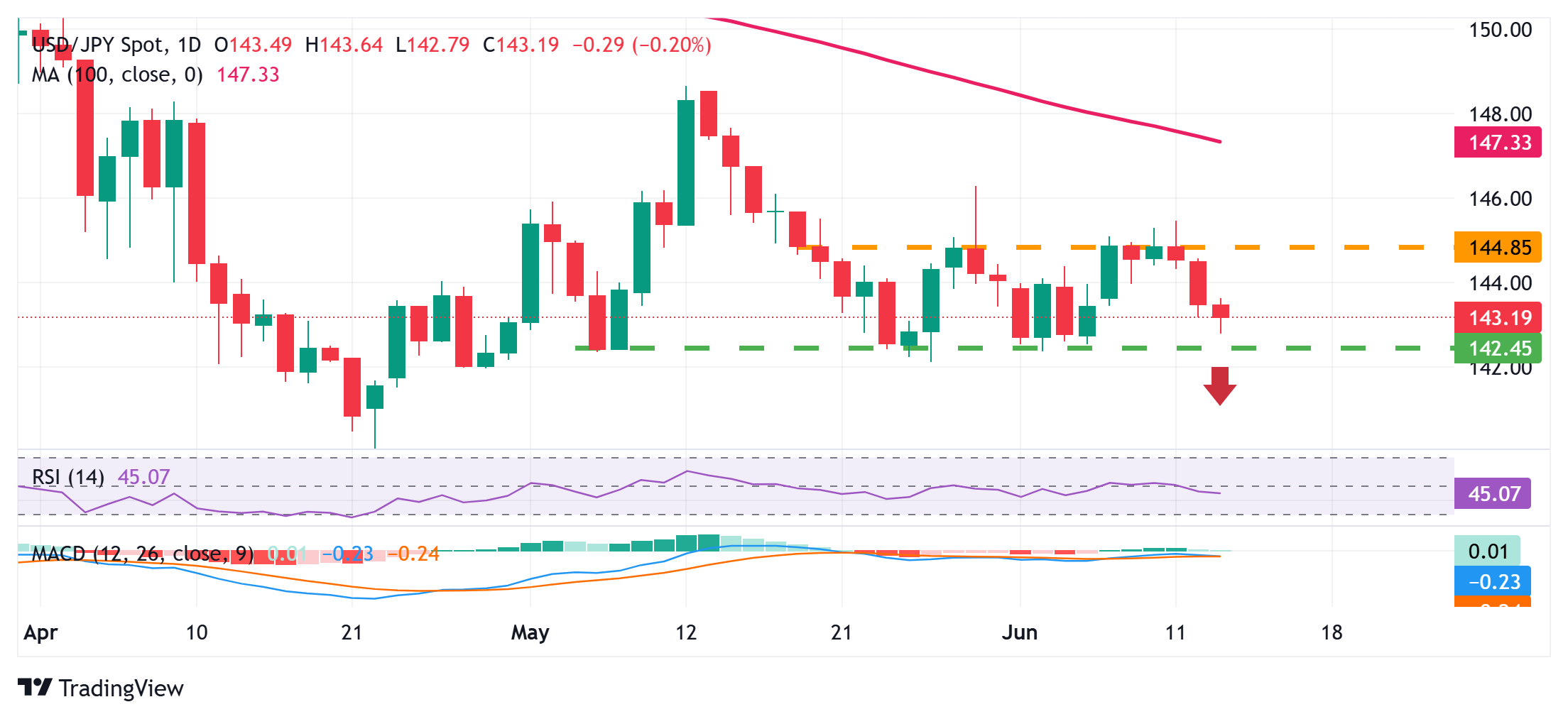Created
: 2025.06.13














![]() 2025.06.13 11:27
2025.06.13 11:27
The Japanese Yen (JPY) advances to over a one-week high against its American counterpart during the Asian session on Friday and draws support from a combination of factors. A further escalation of geopolitical tensions in the Middle East weighs on investors' sentiment and boosts demand for traditional safe-haven assets, including the JPY. Apart from this, the growing acceptance that the Bank of Japan (BoJ) will stick to the path towards monetary-policy normalization turns out to be another factor that contributes to the JPY's relative outperformance.
However, a modest US Dollar (USD) bounce from its lowest level since March 2022 assists the USD/JPY pair pare its heavy intraday losses to the 142.80-142.75 region. Any meaningful USD appreciation, however, seems elusive as signs of cooling inflation and a potential weakening in the labor market lifted bets for an imminent interest rate cut by the Federal Reserve (Fed) in September. This marks a significant divergence from hawkish BoJ expectations, which should continue to benefit the lower-yielding JPY and cap any recovery attempt from the USD/JPY pair.

From a technical perspective, this week's failures to find acceptance above the 145.00 psychological mark and the subsequent fall favor the USD/JPY bears amid negative oscillators on hourly/daily charts. However, it will still be prudent to wait for some follow-through selling below the 142.65 and the 142.35 horizontal support before positioning for deeper losses. Spot prices might then weaken below the 142.00 round figure, towards the 141.65 intermediate support en route to the sub-141.00 levels.
On the flip side, recovery beyond the Asian session peak, around the 143.50-143.55 area, is likely to confront a stiff barrier near the 144.00 mark. A sustained strength beyond the latter might trigger a short-covering move and allow the USD/JPY pair to climb to the 144.50 area en route to the 145.00 round figure. The subsequent move-up could lift spot prices to the 145.45 zone, or a two-week high touched on Wednesday.
The Japanese Yen (JPY) is one of the world's most traded currencies. Its value is broadly determined by the performance of the Japanese economy, but more specifically by the Bank of Japan's policy, the differential between Japanese and US bond yields, or risk sentiment among traders, among other factors.
One of the Bank of Japan's mandates is currency control, so its moves are key for the Yen. The BoJ has directly intervened in currency markets sometimes, generally to lower the value of the Yen, although it refrains from doing it often due to political concerns of its main trading partners. The BoJ ultra-loose monetary policy between 2013 and 2024 caused the Yen to depreciate against its main currency peers due to an increasing policy divergence between the Bank of Japan and other main central banks. More recently, the gradually unwinding of this ultra-loose policy has given some support to the Yen.
Over the last decade, the BoJ's stance of sticking to ultra-loose monetary policy has led to a widening policy divergence with other central banks, particularly with the US Federal Reserve. This supported a widening of the differential between the 10-year US and Japanese bonds, which favored the US Dollar against the Japanese Yen. The BoJ decision in 2024 to gradually abandon the ultra-loose policy, coupled with interest-rate cuts in other major central banks, is narrowing this differential.
The Japanese Yen is often seen as a safe-haven investment. This means that in times of market stress, investors are more likely to put their money in the Japanese currency due to its supposed reliability and stability. Turbulent times are likely to strengthen the Yen's value against other currencies seen as more risky to invest in.
![]()
Created
: 2025.06.13
![]()
Last updated
: 2025.06.13

FXStreet is a forex information website, delivering market analysis and news articles 24/7.
It features a number of articles contributed by well-known analysts, in addition to the ones by its editorial team.
Founded in 2000 by Francesc Riverola, a Spanish economist, it has grown to become a world-renowned information website.
We hope you find this article useful. Any comments or suggestions will be greatly appreciated.
We are also looking for writers with extensive experience in forex and crypto to join us.
please contact us at [email protected].
Disclaimer:
All information and content provided on this website is provided for informational purposes only and is not intended to solicit any investment. Although all efforts are made in order to ensure that the information is correct, no guarantee is provided for the accuracy of any content on this website. Any decision made shall be the responsibility of the investor and Myforex does not take any responsibility whatsoever regarding the use of any information provided herein.
The content provided on this website belongs to Myforex and, where stated, the relevant licensors. All rights are reserved by Myforex and the relevant licensors, and no content of this website, whether in full or in part, shall be copied or displayed elsewhere without the explicit written permission of the relevant copyright holder. If you wish to use any part of the content provided on this website, please ensure that you contact Myforex.
Myforex uses cookies to improve the convenience and functionality of this website. This website may include cookies not only by us but also by third parties (advertisers, log analysts, etc.) for the purpose of tracking the activities of users. Cookie policy